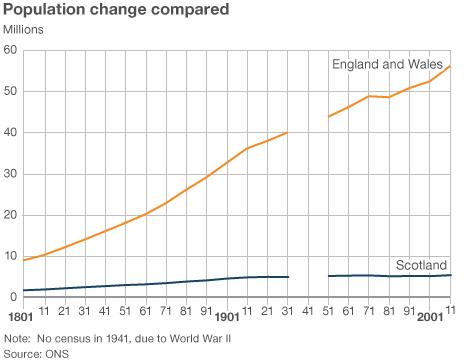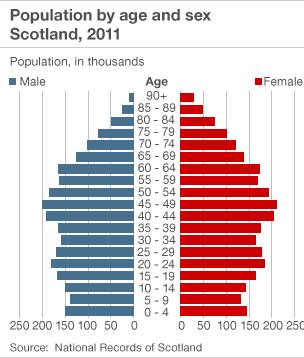11 things we learned from the Scottish 2011 census
- Published
The first results released from Scotland's 2011 Census are not as detailed as the data from England and Wales last week. We will have to wait until next year for such a breakdown of Scotland's figures. However, there is much of interest in the first results.
Scotland's population is the highest ever
The population of Scotland on Census Day 2011 was estimated to be 5,295,000. This is a rise of 233,000 on the previous census in 2001 and represents the fastest growth rate between two censuses in the last century. Scotland's population in 2011 was just over half a million (11%) higher than in 1911.
Scotland's population decline has reversed quickly
From an estimated 1.6 million in 1801, the population increased at a steady rate throughout the 19th and early 20th centuries, reaching 4.9 million in 1921. A dip in the population was recorded in the 1931 Census, in part reflecting the impact of the First World War, the 1918-19 influenza epidemic and net out-migration. It then went up and reached its previous high of 5.2 million in 1971. In the next three censuses the population struggled to stay above five million. But the 2011 survey saw it rise rapidly above the 1971 figure. The drivers for this latest period of population increase are attributed to natural growth (more births than deaths in the most recent years) and net in-migration.
There are more over-65s than under 15s for the first time ever.
The number of people aged 65 and over increased by 85,000 (11%) since 2001. The 854,000 children aged under 15 accounted for 16% of the population whereas those aged 65 and over (890,000 people) accounted for 17%.
There are more females than males
The number of males was 2,567,000 (48%) and there were 2,728,000 (52%) females.
The age group 15 to 39 saw a fall in numbers
The population aged 15 to 64 increased by 200,000 (6%) between 2001 and 2011 but those aged 15 to 39 decreased 2% from 1,734,000 to 1,702,800. Those aged 40 to 64 increased by 14%, from 1,616,000 to 1,849,000.
Scotland is 8.38% of the UK population

The Census Day population in the United Kingdom was almost 63.2 million. Of this, 83.9% were resident in England, 8.38% in Scotland, 4.84% in Wales and 2.86% in Northern Ireland. The resident population of England and Wales on the 27 March 2011 was 56.1 million, a 7% (3.7 million). The Scottish population rose almost 5% over the decade.
The number of children has halved in 100 years

Despite the overall growth in the total population in the past 100 years, the 2011 Census confirmed the pronounced change that has taken place in the age structure of Scotland's population.
The number of children in Scotland has generally fallen since 1911. The census in that year recorded 1,537,000 children aged under 15 (32% of the population).
Apart from increases in the 1961 and 1971 censuses, mainly reflecting the impact of the baby boom years of the 1960s, the number of children in this age group generally fell, reaching a low of 854,000 in 2011, 16% of the population.
In 2011, there were 293,000 children aged under five, an increase of 6% from 2001. However, the number of children aged five to 14 saw a decrease of 69,000 (11%) in the past 10 years.
There are eight times as many people over 80 as 1911
There were nearly eight times as many people aged 80 and over in 2011 (230,000, 4% of the population) than were recorded in 1911 (30,000, 0.6% of the population). In 2011, almost two-thirds (64%) of people aged 80 and over were female.
Scotland's population density is among lowest in Europe
The average number of people per square kilometre in Scotland is 68, among the lowest of the EU countries. It is similar to Ireland and Bulgaria, with only the Baltic and Scandinavian countries having lower population densities. However, there are huge variations across the country. The Western Isles and the Highlands have just nine people per square kilometre whereas Glasgow city has 3,395. The only places outside the Central Belt which have a density greater than 500 are Aberdeen city and Dundee city. The average population density figure for England is over 400.
The population of Scotland is moving around
Highland and Aberdeenshire saw the biggest increases in their population over the past 10 years - up 11%. East Lothian (10%), West Lothian (10%) and Orkney (10%) also saw rises. The number of people in Scotland's big cities also rose but Inverclyde (-4%) and Argyll and Bute (-4%) as well as East Dunbartonshire (-3%) and West Dunbartonshire (-3%) saw a drop.

The census is not absolutely accurate
The statistics provide estimates (rounded to the nearest thousand) of the usually resident population of Scotland on Census Day. It achieved an overall response rate of 94% and the National Record of Scotland says the population is estimated with 95% confidence to be accurate to within +/- 23,000 (0.44%). The figure for England and Wales was broadly similar.
- Published17 December 2012